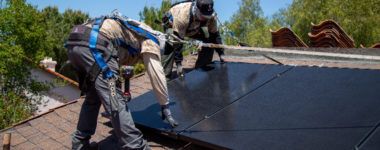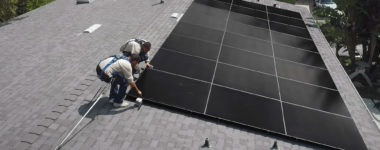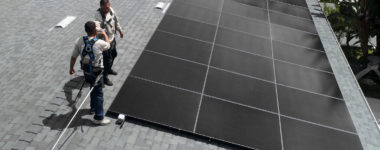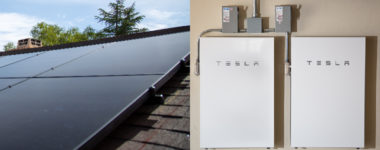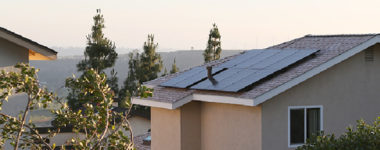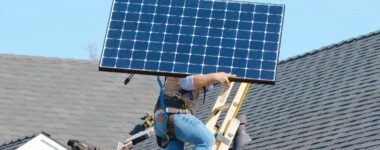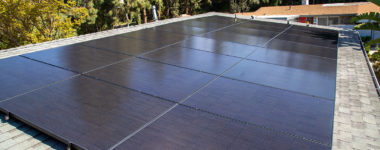Solar Power | Solar Panels, Battery Storage, Roofing, HVAC
Riverside County is already one of the nation's clean energy hot spots. In fact, the entire Inland Empire solar power initiative is in full effect, installing solar panels everywhere! If you've driven from Los Angeles to the Coachella Valley, you've seen the iconic wind turbines in the San Gorgonio Pass and the solar panels that cover thousands of Inland Empire rooftops. Drive further east on Interstate 10, through the open desert, and you'll pass four of the country's biggest solar farms before you hit Arizona. Now, the county is poised to generate even more climate-friendly energy. EDF Renewable Energy has struck a deal to sell electricity from its 150-megawatt Desert Harvest solar project to Marin Clean Energy, a Bay Area power provider. The San Diego-based developer can now start construction on the long-awaited project, which will be built on 1,200 acres of federal land just south of Joshua Tree National Park, next to the existing Desert Sunlight solar farm. The Desert Harvest contract bodes well for the future of clean energy, which experts say will continue to grow even if President Donald Trump aggressively supports fossil fuels, as he pledged to do during the campaign. That growth will be fueled by solar and wind power, which are now the cheapest sources of electricity across much of the country, out-competing coal and natural gas. The Desert Harvest contract is also good news for supporters of community choice aggregation, a new business model through which local governments ditch their utility and buy electricity directly from power plants. Marin Clean Energy, which has been around since 2010, was California's first community choice aggregator, or CCA. It now provides electricity that's significantly greener than the alternative offered by Pacific Gas & Electric, for a comparable price. And it's growing, expanding its customer base from 170,000 to 255,000 this year as more Bay Area cities chose to join. Riverside County is studying whether to form a CCA, as are San Diego and more than a dozen Los Angeles-area cities. A study commissioned by Riverside County earlier this year found that homes and businesses in unincorporated areas alone would save nearly $8 million annually through community choice, with the average home saving between $50 and $55 annually. EDF first proposed Desert Harvest in 2009, winning approval from the federal Bureau of Land Management in 2013. Along the way, the project faced opposition from conservationists who feared it would disrupt habitat critical to the desert tortoise, which is listed as threatened under the federal Endangered Species Act. But two of the major protesters — Defenders of Wildlife and the Natural Resources Defense Council — dropped their objections after the developer agreed to concessions, such as buying private land near the project and setting it aside as protected habitat. "We wanted to have a pathway for desert tortoises and other species that might wander down through that drainage," said Jeff Aardahl, a biologist with Defenders of Wildlife. "We wanted a way for them to escape that and then continue on across the valley, and that's where some of the private land acquisitions would occur."
Having solar panels installed on your home may sound like a good idea, but will it really save you money in the long run? The upfront investment for an average solar energy system in the Bay Area is around $18,000. That home size typically sees a monthly electric bill of about $150. So how do the savings pan out? True, $18,000 is no small chunk of change; however, that price tag doesn’t take the whole picture into consideration. To really understand how much you could save with solar, you have to look at several factors, from NEM 2.0 to federal tax credits. Let’s take a closer look at the long-term investment and payback of a solar panel system below. Incentives & Rebates Available to Bay Area Homeowners One of the biggest draws of a solar panel system is that you get to see your utility bill cut down. Net metering allows you to take advantage of any additional energy you produce that isn’t used up by your household. You’ll be given credits from your electric company to cover any electricity demands you have outside of your solar production (i.e. at night or cloudier days). Another reason going solar is more affordable than you think? The rebates and incentives. The Solar Investment Tax Credit -- which is a 26% tax credit for solar systems -- is a serious perk. Live in San Francisco? Great news -- you could receive another major rebate. GoSolarSF is an initiative that encourages homeowners to install solar panels, offering $300 per kilowatt for average homeowners and an extra $2,000 per kilowatt for any residences who are considered low-income. Additional rebates are available for various factors of the project With these rebates and the federal tax credit, those upfront costs could be majorly rolled back. Don’t Forget the Added Home Value In addition to rebates and cash savings, you also have to consider the perk of increased home value. Down the road, if you want to sell your home, you could be looking at a serious boost in how many potential buyers are willing to put down for your home. In fact, the U.S. Department of Energy did a study that showed homes with solar panel energy systems can increase in value by around $4 per watt. The average system size in the U.S. is 5 kilowatts, which could mean up to $20,000 in added home value that buyers are ready and willing to pay. That’s a value increase in addition to the energy savings you’ve already taken advantage of over the years! Find Out How Much You Could Save Today The amount of money you could save by having a solar panel system install can vary based on a number of factors. For example, the average savings from the lifespan of a home’s 5.7-kilowatt system in the Bay Area lands you around an estimated $72,000. This number can fluctuate based on the size of the solar panel system you install, how much energy your household uses, and even unforeseen changes like spikes in inflation on utility power rates from PG&E. The point is, the savings are real. Exactly how much will you save? Semper Solaris can help you get a better idea when you reach out to our team about your solar options.
As solar energy becomes a more popular renewable energy source, switching becomes more and more attractive to homeowners. There are numerous factors to weigh, especially the cost of investing in solar panels compared to the rising cost of electricity. Any type of change can be somewhat intimidating at first. You may be wondering if switching to solar power would be too much of a hassle or if the panels will even last long enough to make the switch worth it. If you need a little motivation to push you over to the solar side, Semper Solaris is here to help. Top Motivations for Going Solar Promotes a Healthier Environment The earth is full of precious resources that people have been harvesting and using for countless years. However, other resources -- such as certain fossil fuels -- have been causing serious damage to the environment. The health of our environment should far outweigh the benefits of fossil fuels – which is why solar energy has gained significant popularity in the last few decades. The more homes and businesses that switch to solar, the less our world is reliant on more harmful fossil fuels. Instead of being dependent on fossil fuels, a switch to primarily solar can significantly cut back on greenhouse gas emissions. Not only that, but studies have found that if solar energy was adopted on a wider scale, various respiratory problems could be lessened as well. For example, the National Renewable Energy Laboratory found that an increase in solar energy usage vs. fossil fuels would cut back on harmful emissions that can sometimes result in bronchitis, respiratory issues, and even cardiovascular problems. Solar Helps Boost the Economy There is no denying that the market for solar is booming. In fact, the International Renewable Energy Agency reported that solar employment has grown 17 times faster than the rest of the country’s economy. More than 250,000 people were employed in the solar industry in 2017, with numbers expected to continue to grow. Gives You Back Control of Your Utility Bills Having to stress over the rise and fall of electricity costs can be stressful. You have to monitor and track your use, be conservative with your usage at times that may be convenient, and ultimately, don’t have any control over the prices you are charged. The good news? Switching to solar energy gives you back control. With a solar panel system, you are able to convert the sun’s rays into usable energy for all your household needs. Another positive? In most areas, any excess electricity created will go to the grid and be credited back to you, which means during the evening or on cloudy days, you still have your electricity needs covered. These are just a few of the most compelling reasons to switch to solar, so if you’d like to learn more about going solar, our solar panel experts can provide insight.
Semper Solaris is proud to be one of the top solar installers in Southern California. The demand for solar panel systems has never been greater; however, that also means the demand for information and insight on solar energy is also in high demand. We understand that homeowners have lots of questions before diving into the solar energy world – ranging from how much panels cost to how they actually work – which is why we strive to provide all the info they need to make informed decisions. Fact #1: Solar Energy Is Free & Abundant Coming from the powerful rays of the sun, solar energy is a free resource available across the globe. The only costs come from actually harvesting the power of the sun, such as manufacturing, installing, and maintaining a solar panel system. Even still, the fact that the sun is readily available to produce solar energy throughout the day is a reassuring fact in light of the depleting nature of fossil fuels. Fact #2: Solar Is Growing to a Favored Energy Source Solar energy has many advantages and long-term benefits for the planet as a whole. Due to its minimal impact, solar is considered one of the most popular renewable energy sources. Because of this, solar has grown to be a leading renewable energy source, with states like California pushing to be completely renewable energy dependent in less than 30 years. Fact #3: Solar Is a Non-Polluting Energy Source Not only is solar energy considered one of the top sources of renewable energy, but it also counteracts the Greenhouse effect on the earth’s climate. The recent global warming issue is thought to be caused greatly by human’s significant use of fossil fuels. In fact, solar energy doesn’t produce any pollution, which means it doesn’t harm the environment like other energy sources do. While there are other renewable energy sources on the market, solar energy is one of the most broadly accepted and used as technology continues to be developed for converting solar energy into electricity. Fact #4: Solar Panels Are Basically Maintenance Free Unlike other home applications, solar panels require little to no maintenance, making them a hassle-free energy source. Solar panels convert power and send it to batteries that don’t need any service or tune-ups, allowing them to last for years with minimal work. Further, once a homeowner has had their solar panels installed and paid for, there are basically no recurring expenses. Fact #5: The Price of Going Solar Is Becoming More Affordable When solar energy was first introduced, it was used by limited groups. Now, countless homeowners across the country have solar panels installed on top of their homes, allowing them to harvest the power of the sun on a daily basis. As the technology continues to improve and advancements are made in the conversion and storage of renewable energy, the cost of having solar panels installed will continue to become more attainable for homeowners and business owners alike. Solar also helps cut down expenses for homeowners, reducing electricity bills and giving them more control.
There has been a rising interest in solar battery storage in recent years. While most homes are still tied to power grids, a solar battery like Tesla Powerwall would allow homeowners to move closer to being “off the grid” for good. For most, the allure of complete autonomy when it comes to electricity production and usage is very enticing. One of the biggest perks of having a solar panel system is to provide more self-sufficiency, after all, and a solar storage battery is just another step towards independence from utility companies that continue to hike electricity prices. That is why we are going to take a look at the benefits and pitfalls of both traditional grid-tied solar power systems and solar power systems backed by battery storage. How Does a Grid-tied Solar Power System Work? Having a solar power system for your home gives you much more control over your electricity usage. You are able to harness the power of the sun and convert it into usable energy, majorly cutting back on utility expenses. But will solar panels produce enough power for your home? What about those times when the sun doesn’t shine through the clouds or a stormy day hampers energy production? For most homeowners, the solution is being tied to a power grid. For any energy demands they have that their solar production doesn’t cover, they will start pulling from the power grid instead. Even though homeowners essentially have to “buy” energy during these times, they often have credits to cover the expenses. This means that during evening hours without sunlight, cloudier days, or other circumstances, homeowners can still ensure their electricity needs are covered -- and still benefit from previous over-production of electricity needs. In some states, homeowners can even earn money for any additional electricity their panels have produced that they don’t use from the grid. There is also great assurance knowing that there will always be some source of power to pull from should a home’s solar panels not provide the electricity needed. As states continue to adopt models for charging solar panel customers, power companies stand to benefit the most from having customers still tied to the grid. This also means that the threat of facing time-of-use rates and other spikes in utility costs is still very real for homeowners with a grid-tied solar power system. How Does a Battery Storage Solar Power System Work? In theory, a solar power system that has a solar storage battery could be completely grid-free. That means homeowners have ultimate control over their electricity needs. They don’t have to worry about using credits to cover additional energy demands during low production hours, time-of-use rates, or other challenges that come with a regular grid-tied system. Battery technology isn’t new, but using batteries for home solar power storage is still not widespread yet. However, the interest in energy storage is growing greatly. As products continue to be developed, the efficiency and storage capacity of these batteries will continue to improve. However, some home electricity demands would still exceed the storage capacity of a solar battery. If you tried to go completely “off the grid,” you could be left without power once you depleted your backup resource until the sun comes back out. Why a Hybrid System Is Gaining Popularity It is clear that both a grid-tied system and battery-backed system boast plenty of perks – and challenges alike. Instead of weighing the pros and cons to the point of pulling out your hair, consider an alternative solution: a hybrid system. A hybrid solar power system can include the pros of both sides, while essentially eliminating the cons. A home can have the perks of being tied to the grid for any energy needs they have once they’ve used up their solar panel production and battery storage. Homeowners have the ability to draw electricity from both their local power grid, as well as from their home solar batteries. They can choose to invest in more solar batteries for more independence overtime or simply get one for backup purposes. Having a hybrid system also gives homeowners more flexibility and control. They may choose to reserve their solar power storage for emergency usage only, after the sun goes down, or as backup in case electricity prices surge during certain hours of the day. Combining a grid-tied system and battery system allows for a consistent and more controlled flow of energy throughout the day and night for homeowners. When is a hybrid system the most desirable? For homeowners who live in an area without favorable compensation rates for excess electricity produced by solar panels, having a hybrid system can be crucial. Rather than simply sending excess electricity to the grid at a low rate, a homeowner can save some of that valuable electricity for future use, only sending what they don’t use or store. How California’s Net Metering Policy Has Changed Homeowners who live in California may be even more inclined to consider a hybrid solar power system. Net Metering 2.0 (NEM 2.0) is an update to California’s original policy on net metering, now including time-of-use rates, non-bypassable charges, and some additional fees. The estimated additional cost will jump up to around $10/month for an average homeowner. The time-of-use rates will be the biggest adjustment for many homeowners, which will adjust the credit given for solar electricity depending on the time of day it was produced. Typically, any excess electricity that is sent back to the grid during higher demand or peak hours will be given more credit. Overall, the policy is still favorable for homeowners, but having a solar battery to store excess electricity can provide more flexibility to bypass lower time-of-use rates and send by electricity during those peak value hours. Whether you are considering completely disconnecting from your local power grid with solar storage batteries or just want to create the most efficient home solar power system, talk to Semper Solaris about your battery options today.
For many people, saving the planet or helping the environment sounds like a good thing, they just don’t know where to start. Even if you aren’t sure that “going green” is something you really want to do, consider this: helping the environment doesn’t just save the planet, it helps save your quality of life. Since you are daily breathing in the air from your environment, wouldn’t you want to keep it as clean and “green” as possible? Solar energy has numerous benefits, including the ability to help decrease respiratory and cardio health problems. That alone should be motivation enough for homeowners to go solar – and then you add in the cost-saving perks and things start to sound too good to be true (trust us, it’s the real deal). Check out some of the environmental benefits of installing solar panels below! How Solar Energy Is Paving the Way for a Better Tomorrow Better Air Quality Nothing like being able to breathe easy, especially in Southern California. Wouldn’t it be nice if we didn’t have to worry about the quality of air we breathe every day, but could just know it was clean and pure? Solar energy moves us towards a green source of energy, putting a stop to so many of the harmful air pollutants we are subject to when we step outside our homes. According to an analysis done by the National Renewable Energy Laboratory, if solar become the major energy provider, it would create a major reduction of sulfur dioxide, nitrous oxides, and other harmful emissions that lead to health concerns. Reduced Pollution & Consumption of Water Sources Did you know that natural gas and coal energy plants are reliant on large amounts of water to create their energy sources? In comparison, solar panel manufacturing only requires a minimal amount of water. After that, they don’t require any valuable local water sources to provide electricity to homes. Switching to solar would cut back on the water-sucking cooling requirements of biomass and geothermal power plants, eliminating competition with drinking water, agriculture resources, and more. Especially in California, we know that water is a precious resource that can’t be taken for granted – especially in times of drought. Solar energy can help eliminate the large usage of water simply to create power resources. Cuts Back on Emissions of Greenhouse Gas We all hear about how bad greenhouse gas emissions are, but what can we do to fix it? By opting for solar power to generate our electricity instead of harmful fossil fuels, we can cut back on the emission of gases like CO2, which can lead to rising temperatures on the planet, creating a more drastic climate change. The U.S. Energy Information Administration found that a household that switches to solar power instead of fossil fuels can have a similar impact as planting 150+ trees (depending on the region). For example, an average home in New York uses around 7,092 kWh of electricity on a yearly basis – that would require roughly 5,250 pounds of coal to be burned per year to produce just that single home’s energy. Imagine if all the homes in New York switched to solar and were able to cut back that much on greenhouse gas emissions? More than that, solar energy is a renewable source of energy, rather than a finite one. The sun’s energy can be used repeatedly without any fear that it will run out like fossil fuels. The sooner we become dependent on infinite solar energy rather than finite alternatives, the better. Don’t wait any longer to start doing your part for the environment. Go solar today and go green. Contact Semper Solaris if you have questions about switching to solar.
Every single hour, the sun pours 430 quintillion Joules of energy onto the earth. That’s enough energy to power our blenders, cars, airplanes, air conditioning, and every other human energy need for an entire year! It seems like we should be able to find a way to harness all that sunlight, right? Well, that’s exactly what solar panels are designed to do. If you’ve considered installing a solar power system on your home, you probably want to know how thin panels on a roof can charge your electric car or keep your home nice and cool during a particularly hot California summer. Below, we’ll dive into the science of solar energy. Don’t worry, you won’t need a chemistry degree to keep up. We’ll break down the process step-by-step and make it easy to understand how solar power for your home is possible. How Solar Panels Turn Sunlight into Solar Energy The central challenge in using the sun to power homes and cities is figuring out how to turn sunlight into a power source we can actually use. In a nutshell, solar panels work by turning photons from the sun into electrical energy. Unfortunately though, you can’t use photons to power your cell phone or keep the lights on at night until it is turned into electricity. And the conversion process starts with a special substance called silicon, a crystalline element with strong semi-conductive properties. While other semiconductor materials can be used, the vast majority of solar panels are made of silicon, because it is one of the most common elements on the planet and is therefore easier to access (and less expensive) than other options. For each panel of photovoltaic cells, there is silicon sandwiched between the conductive layers. Here’s where the process gets a little sciencey, because each layer is slightly modified. The top layer is changed so that it holds a negative charge, while the bottom layer is turned into a positive charge. The attraction of these two layers (negative and positive charges are drawn to each other) creates a powerful electric field, which is a key ingredient in the solar panel recipe. Next, it’s time for a quick chemistry lesson and then lots of sunshine. It’s All About the Electrons Like every element on earth, silicon is made up of numerous tiny atoms. An atom contains a stable nucleus of neutrons and protons surrounded by zipping electrons. For our purposes, we’ll just focus on those electrons. Electrons have a negative charge and are drawn to the positive charge of protons. This bond isn’t unbreakable, though. In fact, electrons can be stolen by other elements or knocked out of their atoms by an intruder. This is exactly what happens when photons come pouring down on a rooftop solar system during a sunny day. Those little photons knock electrons out of their orbits, and the electric field kicks them out of the silicon field junction altogether. Don’t worry, these little guys aren’t lost, though. They just need to take the long way round. After electrons are booted from the silicon field, they’re captured by an external circuit. The electrons flow down the circuit, and this is what creates electricity. Eventually, the electrons return to the solar cell where they align back into the orbit of a silicon atom that needs an electron. In this way, nothing is lost or used up - like when fossil fuels are burned to create electricity. In fact, a solar panel system is completely self-contained and helps many people create self-sustaining homes in California. Converting Solar Power into Usable Energy The power created by that journeying electron we just mentioned isn’t quite ready to go right down into your electric socket and power on your stove in the morning. One more conversion has to happen. Solar panels turn photons into a special type of current called a direct current (DC), but here in the United States, our electrical grid runs on an alternating current (AC). This means that no solar power system is complete without a special device called a inverter. Despite its name, an inverter doesn’t turn DC into AC. Rather, the direct current powers the creation of the alternating current, which can then be used to power a home. The final destination for your alternating current will depend on the setup of your solar power system. Most homeowners in San Diego and other parts of California are part of the net metering system, which means that the excess electricity produced by their solar panels goes into the public utility grid. If you have this system, your electricity meter will actually tick backwards when your system produces more electricity than you can use. At night or on cloudy days when you need to use more electricity than the solar panels on your home can produce, the system will automatically pull electricity from the grid and your meter will go forward. A well-designed solar power system should balance out each month, producing the amount of electricity you need so that your electric bill is low, non-existent, or even shows a net gain. The other option is to install a solar battery in your home that can collect the excess electricity your system produces. At night or on cloudy days, you can power your house from the battery. Battery technology continues to improve, and it might be the right option for those who live off the grid or who want to be as self-sufficient as possible. Now You’re Solar Smart Now that you have a basic understanding of how solar panels work, remember that a single photovoltaic cell can only produce a little bit of energy. It might create enough to charge your cell phone, but not nearly the amount you need to keep your home humming - which is why each solar panel is made up of many photovoltaic cells, and panels are combined to create a complete solar power system. Several factors go into determining exactly how many solar panels you will need for your home, such as the size of your roof, your electricity needs and the amount of sunlight your home receives throughout the year. That’s why we always recommend getting a complete energy analysis and onsite evaluation. At Semper Solaris, we believe it’s important to make sure you have a solar power solution that fits your needs, which is why our evaluation is free. We want you to understand exactly what you’re paying for and how your new investment works, so don’t hesitate to call or email us with your questions!
Homeowners have installed over 580,000 solar panels in California alone, saving thousands of dollars on their energy bills. Since 2007, the costs associated with installing solar panels have dramatically decreased. Best of all, the U.S. Energy Information Administration predicts solar panel prices will remain at a steady low until at least 2035. Since utility costs keep rising, now is the perfect time to install solar panels on your home. With more homeowners interested in solar energy, we’d love to help you by answering common questions. Learn more about solar panel installation and solar energy in general from Semper Solaris. Can I afford to install solar panels? We’ve come a long way since solar panels were first created. Solar panels are now more affordable than ever, and all kinds of rebates and financing programs have been created in recent years. For example, the HERO Program can help approved homeowners pay for their solar panels through their property taxes rather than through high upfront costs. There are also currently several rebates and tax incentives offered by both federal and state governments to help you create renewable energy through photovoltaic (PV) systems. In addition, many companies offer special financing or discounts. How do solar panels save me money? By using solar energy, you can lower your electricity costs or even bring them down to zero. Through a process called net metering, several homeowners with solar panels actually receive money from the electricity company for all the extra energy that they produce! For homeowners with families, who run the air conditioning often, or who run a lot of appliances and technology, solar panels can mean saving hundreds of dollars per month. In California, “grid parity” has currently been reached, meaning that the costs of installing solar panels are officially less than the costs of paying the average electricity bill each month. Also, unlike your electricity bill, your solar panel payments will eventually all be paid off. How often do I have to maintain them? One of the best features of solar panels is that they require very little maintenance. For example, at Semper Solaris we only use the most efficient solar panels on the market that come with a 25-year bumper-to-bumper warranty, meaning that they’re built to last 25 years with little to no work on the homeowner’s part. Any solar company should work with you to ensure that there are no obstructions that could decrease your panels’ ability to soak in the sunlight, but you may have to occasionally trim branches or other blockages that grow close to your roof. Solar panels don’t usually have to be cleaned in order to continue to work well, but you’re free to hose them off to keep them always looking new. What do I have to do to install solar? Most of a homeowner’s work in installing solar panels is in finding the right solar company. But once you find the contractor that’s right for you, they should take care of the rest. A good solar company will be licensed, have excellent ratings with the Better Business Bureau and Angie’s List, and will keep you well informed about the installation process. Once a solar company has the proper permits from local governments, the installation process should be very quick and simple. Where do I go for more information? Contact local and veteran owned Semper Solaris and we’ll be happy to answer your questions about solar panels—and give you a free energy analysis.
Solar power is one of the most plentiful renewable energy sources in the world, especially in areas such as California that enjoy the benefits of clear skies on a regular basis. Some people may be resistant to the idea of solar power because they simply don't understand how solar panels work. However, solar power is a solid choice for residents in the San Diego area. If you're not sure how solar panels work, you've come to the right place. The Rundown on Solar Power In short, solar power provides electricity for homes and buildings. It is so effective that it can be used in place of traditional electricity or other sources of energy. The word “solar” comes from the Latin word for “sun.” “Solar power” refers to the powerful energy we get from the sun. Thousands of years ago, people realized the power of the sun, and even then, people tried to use solar power to make their homes more comfortable in the winter. It’s a reliable, eco-friendly energy that doesn’t run out and doesn’t create pollution the way some sources of energy, such as gas or coal, can. Today, especially in California, solar power is a fitting source of energy, thanks to the state’s conducive climate. Harnessing Solar Energy in California As the sun shines down on the Earth, different areas can collect different amounts of solar power. San Diego, California, for example, is a warm and sunny city that gets a lot of intense sunlight throughout the year. In fact, all of Southern California is an ideal place for solar energy collection. California solar power companies in this area use solar thermal collectors, which absorb heat energy from the sun. This energy is then used to heat water or make electricity. If a system is big enough, the cells that turn sunlight into electricity can even make enough electricity for a whole neighborhood. An area that’s open to the sky and without too many trees overhead is needed to collect solar energy. Solar Energy Four Ways to Do Solar Energy Solar Energy Technology Basics Solar Power Saves Everyone Money How Solar Panels Work Solar panels are set up so that the sun shines down on them at an ideal angle. When the sun hits the panels, tiny solar cells, also called photovoltaic cells, absorb the sunlight. These cells might be as small as a half an inch or as large as 4 inches each. The solar cells then absorb the energy and use it to move electrons to a second layer of the cells. When the electrons hit the second layer, this action forces other electrons to move down, too. This movement of electrons is actually electricity, which can power appliances in a house. In the United States, California solar power is prominent due to the abundant sunshine and heat in this area. California was early to adopt the solar power movement. For example, the Mojave Desert in southern California has a solar power plant that has been running for decades. Solar Energy How Solar Panels Work: A Simple Explanation The Environment: Solar Energy How Does Solar Power Work? Renewable Energy Sources Solar Power Learn About Solar Power How You Can Use Solar Energy in the Home Whether you live on the coast, inland, atop rolling hills, or in the mountains, California residents in all regions can find multiple uses for solar energy in the home. With solar panels, you can collect solar energy to use for air conditioning, to heat water, and to power appliances. A battery can store extra energy so that the house can have power at night and on cloudy days, like those signature “May Gray and “June Gloom” months sunny SoCal often experiences. Solar Basics Solar Power Facts DIY Projects Using the Sun A Kid’s Guide to Solar Power in the Home Meet the Sun Power People Should You Put Solar Panels on Your House? Kids Can Learn About Solar Power Some Solar Energy Fun California solar power is leading the future of energy. Want to learn more about solar energy? Activities like building a solar oven with a box, aluminum foil, and a few other materials can show you how to use the power of the sun to cook a fun snack. You could build a solar night-light out of a jar and a solar path light. Try out the following games, experiments, and activities to get a hands-on experience with solar energy. Solar Energy Coloring Book (PDF) How Solar Panels Work (video) Energy Games and Icebreakers Energy City Interactive Game California Solar Power Regions Served by Semper Solaris Take a look at the top locations we serve in California to find out more information about your city. San Diego Solar Orange County Solar Bay Area Solar Los Angeles Solar Inland Empire Solar If you’re interested in learning more about how solar panels work and how solar panels for home use can benefit you, contact a specialist such as Semper Solaris today.
